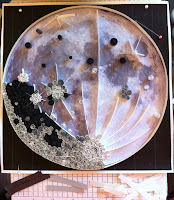 |
| Some progress! |
 |
| Even more progress! |
As of this moment, I've finally completed my Moon, but I want to post some of the intermediate pictures to show the progress. So I'll be finishing up the Moon blogging in another post or so. But for now, compare the two images here and you can see how the edge of the Procellarum basin expanded towards the center of the image, and how the highlands were filled in from the right.
The mare sections at the top and left of Copernicus crater were really challenging. As I approached the bottom of the Imbrium basin, I got more and more nervous about exactly how the basins would 'express' themselves. I wanted them to be bold and easily recognized, but didn't want to lose the subtlety of the interesting margins, and of the craters and their ejecta. So I moved very carefully, filling in the area to ensure that the basin would have an obvious round edge to it, but also ensuring that all the important tiny features could still be seen.
 |
Close up of the area around
Copernicus. |
Looking at the close up image makes this all seem so straightforward and easy! But since every single quill was created on the fly - size, color, and placement - it was really very difficult. But I do like the general effect. It is certainly the Moon, and it has a strong mosaic look without losing the lacy feel that quilling offers.
What I'm starting to worry about now is how to hide the errors I'm spotting. Like how my Moon is not a perfect circle anymore. Pressure from the different areas as I glued them in place slowly altered the nature of the outline - it isn't quite a perfect circle. I can see flatter areas, and areas with slight bulges. Not sure how to hide this - I was already planning to put mat board around the outline, so perhaps this will make the project look more even.
Image Credits - My pix of my own quilling, my design!












